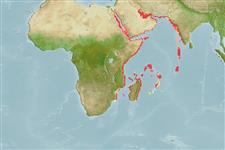Common names from other countries
>
Mulliformes (Goatfishes) >
Mullidae (Goatfishes)
Etymology: Parupeneus: Latin, parum, parvum = small + Peneus, the name of a river.
More on authors: Randall & Guézé.
Environment: milieu / climate zone / depth range / distribution range
Ekologi
laut berasosiasi dengan karang; kisaran kedalaman 1 - 55 m (Ref. 54393). Tropical
Western Indian Ocean: Persian Gulf and the Gulf of Oman to western Pakistan.
Size / Weight / umur
Maturity: Lm ? range ? - ? cm
Max length : 23.0 cm TL jantan/; (Ref. 11441)
deskripsi pendek
Kunci identifiaksi (pengenalan) | Morfologi | Morfometrik
Duri punggung (Keseluruhan (total)) : 8; duri punggung lunak (Keseluruhan (total)) : 9; Duri dubur: 1; Sirip dubur lunak: 7; vertebrata, bertulang belakang: 24. Diagnosis: Pectoral rays 15-17 (usually 16). Gill rakers 6-8 + 22-25 (total 29-33). Body moderately elongate, the depth 3.5-4.05 in SL (to 4.35 in juveniles); head length (HL) 2.75-3.0 in SL; snout length 1.75-2.3 in head length; upper-jaw length 3.0-3.5 in HL; barbels relatively short, 1.4-1.65 in HL; third dorsal spine longest, 1.65-1.95 in HL; last dorsal soft ray only slightly longer than penultimate ray; pectoral-fin length 1.5-1.7 in HL; pelvic-fin length 1.5-1.8 in HL. Gray to brownish red dorsally, whitish to light red ventrally, with a small pearly white to pale blue spot on each scale of body below the lateral line (center of scales on body above lateral line whitish but not as a distinct spot); an elongate white spot anteriorly on upper side of caudal peduncle, sometimes followed by a dusky spot of about the same size; a brown band on snout from upper lip to eye, often continuing onto postorbital head and narrowly a short distance onto body (band usually not persisting in preservative) (Ref. 54393).
Occurs on open sand or silty sand bottom or on sand and rubble in the vicinity of reefs or rocky outcrops (Ref. 54393).
Life cycle and mating behavior
Maturities | Reproduksi, perkembang biakan | Spawnings | Egg(s) | Fecundities | Larva
Randall, J.E., 2004. Revision of the goatfish genus Parupeneus (Perciformes: Mullidae), with descriptions of two new species. Indo-Pac. Fish. (36):64 p. (Ref. 54393)
Status IUCN Red List (Ref. 130435)
CITES (Ref. 128078)
Not Evaluated
ancaman kepada manusia
Harmless
penggunaan manusia
Alat, peralatan
laporan khas
muat turun XML
Sumber internet
Estimates based on models
Preferred temperature (Ref.
115969): 25.5 - 29.3, mean 27.3 (based on 238 cells).
Phylogenetic diversity index (Ref.
82804): PD
50 = 0.5000 [Uniqueness, from 0.5 = low to 2.0 = high].
Bayesian length-weight: a=0.01202 (0.00556 - 0.02601), b=3.10 (2.93 - 3.27), in cm Total Length, based on LWR estimates for this Genus-body shape (Ref.
93245).
Trophic level (Ref.
69278): 3.4 ±0.4 se; based on size and trophs of closest relatives
Daya lenting (Ref.
120179): Tinggi, Waktu penggandaan populasi minimum kurang dari 15 bulan (Preliminary K or Fecundity.).
Fishing Vulnerability (Ref.
59153): Low vulnerability (13 of 100).
